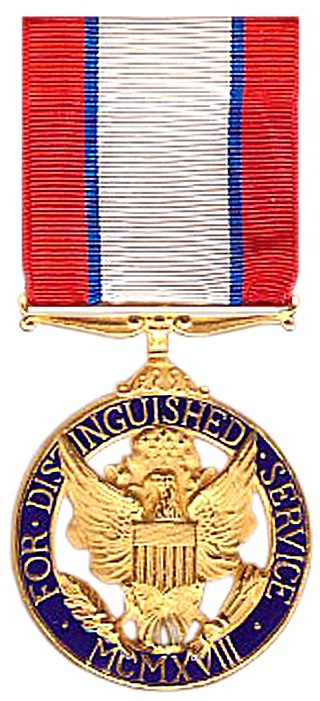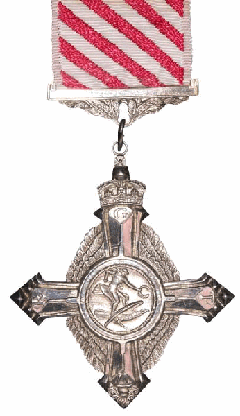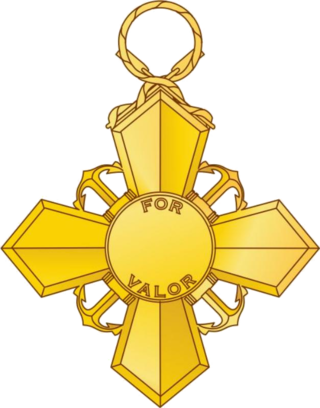
The Bronze Star Medal (BSM) is a United States Armed Forces decoration awarded to members of the United States Armed Forces for either heroic achievement, heroic service, meritorious achievement, or meritorious service in a combat zone.

The Distinguished Service Medal (DSM) is a military decoration of the United States Army that is presented to soldiers who have distinguished themselves by exceptionally meritorious service to the government in a duty of great responsibility. The performance must be such as to merit recognition for service that is clearly exceptional. The exceptional performance of normal duty will not alone justify an award of this decoration.

The Legion of Merit (LOM) is a military award of the United States Armed Forces that is given for exceptionally meritorious conduct in the performance of outstanding services and achievements. The decoration is issued to members of the eight uniformed services of the United States as well as to military and political figures of foreign governments.

The Silver Star Medal (SSM) is the United States Armed Forces' third-highest military decoration for valor in combat. The Silver Star Medal is awarded primarily to members of the United States Armed Forces for gallantry in action against an enemy of the United States.

The Defense Superior Service Medal (DSSM) is a military decoration of the United States Department of Defense, which is presented to United States Armed Forces service members who perform superior meritorious service in a position of significant responsibility.

The Civil War Campaign Medal is considered the first campaign service medal of the United States Armed Forces. The decoration was awarded to members of the United States Armed Forces who had served in the American Civil War between 1861 and 1865.

The Air Force Cross (AFC) is a military decoration awarded to officers, and since 1993 other ranks, of the British Armed Forces, and formerly also to officers of the other Commonwealth countries. It is granted for "an act or acts of exemplary gallantry while flying, though not in active operations against the enemy". A bar is added to the ribbon for holders who are awarded a further AFC.
The Armed Forces Expeditionary Medal (AFEM) is a military award of the United States Armed Forces, which was first created in 1961 by Executive Order of President John Kennedy. The medal is awarded to members of the U.S. Armed Forces who, after July 1, 1958, participated in U.S. military operations, U.S. operations in direct support of the United Nations, or U.S. operations of assistance for friendly foreign nations.
The World War I Victory Medal was a United States service medal designed by James Earle Fraser of New York City under the direction of the Commission of Fine Arts.
The European–African–Middle Eastern Campaign Medal is a military award of the United States Armed Forces which was first created on November 6, 1942, by Executive Order 9265 issued by President Franklin D. Roosevelt. The medal was intended to recognize those military service members who had performed military duty in the European Theater during the years of the Second World War.
The American Campaign Medal is a military award of the United States Armed Forces which was first created on November 6, 1942, by Executive Order 9265 issued by President Franklin D. Roosevelt. The medal was intended to recognize those military members who had performed military service in the American Theater of Operations during World War II. A similar medal, known as the American Defense Service Medal was awarded for active duty service before the United States' entry into World War II.
The Mexican Border Service Medal was a U.S. service medal established by an Act of Congress on July 9, 1918. It was awarded for service on the border between May 9, 1916 and March 24, 1917. Additionally, recipients included those who performed duty with the Mexican Border Patrol between January 1, 1916 and April 6, 1917.
The China Campaign Medal is a decoration of the United States Army which was created by order of the United States War Department on January 12, 1905. The medal recognizes service in the China Relief Expedition which was conducted by the United States Army at the turn on the 20th century during the Boxer Rebellion.
The Philippine Congressional Medal was a service medal of the United States Army which was established by the United States Congress on 9 July 1906. The medal recognized those soldiers who had enlisted in the United States Army for the purpose of the serving in the Philippine–American War.
The Spanish War Service Medal was a United States military medal of the U.S. Army which was established by an act of the U.S. Congress on 9 July 1918. The medal recognizes those members of the Army and of the U.S. Volunteers who performed active duty during the Spanish–American War, but did not qualify for the Spanish Campaign Medal.
The Army of Cuban Occupation Medal was a military award created by the United States War Department in June 1915. The medal recognizes those service members who performed garrison occupation duty in the United States Protectorate over Cuba, following the close of the Spanish–American War.
The Army of Puerto Rican Occupation Medal was a service medal of the United States Army which was created by order of the United States War Department on 4 February 1919. A retrospective award created decades after the action commemorated, the medal recognized Army service from 14 August through 10 December 1898 in Puerto Rico. The Army of Puerto Rican Occupation Medal was commemorative by nature although was approved for wear on active military uniforms. A similar medal, the Army of Cuban Occupation Medal was created for occupation service in Cuba following the Spanish–American War. The regulations for the Army of Cuban Occupation Medal were re-written to include regulations for the Army of Puerto Rican Occupation Medal.

The Texas Cavalry Medal was a United States service medal established by an Act of Congress on April 16, 1924. It was awarded for service in the Texas Cavalry between September 25, 1918 and November 11, 1918.

The Honour Cross of the World War 1914/1918, commonly but incorrectly known as the Hindenburg Cross or the German WWI Service Cross, was established by Field Marshal Paul von Hindenburg, President of the German Weimar Republic, by an order dated 13 July 1934, to commemorate service of the German people during the First World War. This was Germany's first official service medal for soldiers of Imperial Germany who had taken part in the war, and where they had since died it was also awarded to their surviving next-of-kin. Shortly after its issuance, the government of Nazi Germany declared the award as the only official service decoration of the First World War and further forbade the continued wearing of most German Free Corps awards on any military or paramilitary uniform of a state or Nazi Party organization.

The Coast Guard Cross (CGC) is the United States Coast Guard's second highest military decoration for Coast Guardsmen who distinguish themselves extraordinary heroism in combat with an armed enemy force. Established by Act of Congress on 15 October 2010, it is intended to recognize members of the United States Coast Guard for extraordinary heroism in action. Coast Guardsmen serving under the Department of the Navy would be eligible for the Navy Cross. This medal, though approved, has not yet been awarded. By virtue of having never been awarded, it is the rarest United States military award.









